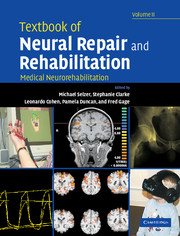Book contents
- Frontmatter
- Contents
- Preface
- Contributors
- Contributors
- Neural repair and rehabilitation: an introduction
- Section A Technology of neurorehabilitation
- Section A1 Outcomes measurement and diagnostic technology
- Section A2 Therapeutic technology
- Section B Symptom-specific neurorehabilitation
- Section B1 Sensory and motor dysfunctions
- 15 Chronic pain
- 16 Loss of somatic sensation
- 17 Management of spasticity
- 18 Arm and hand weakness
- 19 Gait disorders and rehabilitation
- 20 Balance, vestibular and oculomotor dysfunction
- 21 Deconditioning and energy expenditure
- Section B2 Vegetative and autonomic dysfunctions
- Section B3 Cognitive neurorehabilitation
- Section C Disease-specific neurorehabilitation systems
- Index
- Plate section
18 - Arm and hand weakness
from Section B1 - Sensory and motor dysfunctions
Published online by Cambridge University Press: 04 August 2010
- Frontmatter
- Contents
- Preface
- Contributors
- Contributors
- Neural repair and rehabilitation: an introduction
- Section A Technology of neurorehabilitation
- Section A1 Outcomes measurement and diagnostic technology
- Section A2 Therapeutic technology
- Section B Symptom-specific neurorehabilitation
- Section B1 Sensory and motor dysfunctions
- 15 Chronic pain
- 16 Loss of somatic sensation
- 17 Management of spasticity
- 18 Arm and hand weakness
- 19 Gait disorders and rehabilitation
- 20 Balance, vestibular and oculomotor dysfunction
- 21 Deconditioning and energy expenditure
- Section B2 Vegetative and autonomic dysfunctions
- Section B3 Cognitive neurorehabilitation
- Section C Disease-specific neurorehabilitation systems
- Index
- Plate section
Summary
Introduction
The generation of controlled and precise contractile forces in our skeletal muscles is what fundamentally allows us to maintain posture, manipulate objects, and interact with our environment (Ghez, 1991). In this context, what we generally term “weakness” is often a major reason for loss of control in the genesis of a muscular contraction. Muscle weakness can occur from lesions at various levels of the nervous system that impact the output of either the upper motor neuron (UMN) or lower motor neuron (LMN). Disorders of LMNs refer to lesions that occur in the cells of the ventral gray column (or “horn”) of the spinal cord or brain stem or in their axons (Waxman, 2003) and are discussed in more detail in Chapter 40 of Volume II, “Neuromuscular Rehabilitation: Diseases of Motor Neuron, Peripheral Nerve and Neuromuscular Junction”. UMN lesions, occurring as a result of damage to the cerebral hemispheres or lateral white columns of the spinal cord (Waxman, 2003), are typically caused by strokes, traumatic brain injuries, infections, or tumors. Muscle weakness is considered one of the major causes of disability in patients with UMN lesion (Sahrmann and Norton, 1977; Gowland et al., 1992; Fellows et al., 1994). In light of this fact and considering that the primary symptom of cerebral injury is manifested in impairments of strength and motor control, the concept of weakness can be viewed in the context of stroke and traumatic brain injury.
Accordingly, the purpose of this chapter is to identify and describe weakness of the upper extremity (UE) through exploration of impairment in movements following cerebral injury. The present perspective of weakness is presented with respect to strength and the consequent …
Keywords
- Type
- Chapter
- Information
- Textbook of Neural Repair and Rehabilitation , pp. 265 - 282Publisher: Cambridge University PressPrint publication year: 2006
- 1
- Cited by

